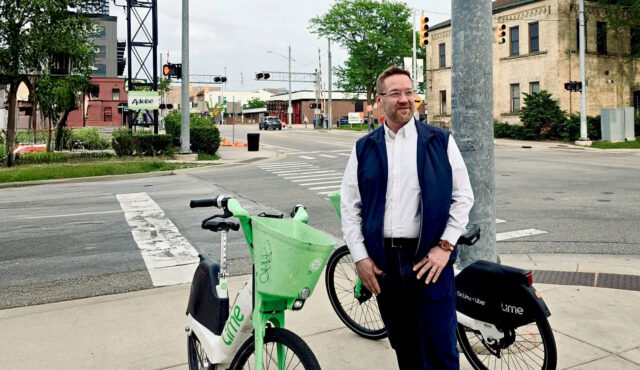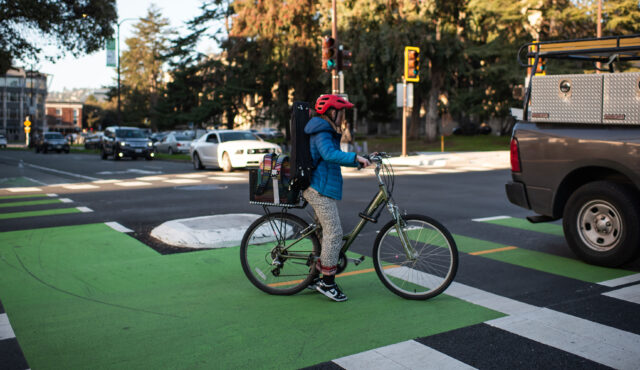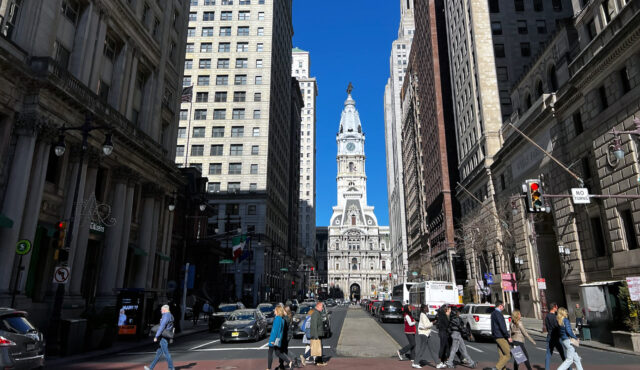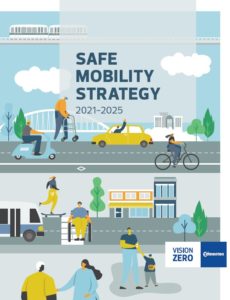 A new generation of Vision Zero actions plans in North America was ushered in by the inauspicious December 1 meeting of the City of Edmonton (Alberta) Urban Planning Committee. Councillors and members of the public spoke with great passion in support of the proposed Safe Mobility Strategy 2021-2025, following a constructive and well-informed discussion of recommended implementation steps. The City Administration has adopted the plan and is now moving quickly to bring it to life.
A new generation of Vision Zero actions plans in North America was ushered in by the inauspicious December 1 meeting of the City of Edmonton (Alberta) Urban Planning Committee. Councillors and members of the public spoke with great passion in support of the proposed Safe Mobility Strategy 2021-2025, following a constructive and well-informed discussion of recommended implementation steps. The City Administration has adopted the plan and is now moving quickly to bring it to life.
“Our elected leaders and the vast majority of Edmontonians are focused not on debating the merits of the work but on how quickly we can work to live out the strategy. It’s a beautiful thing, shared vision.”
Jessica Lamarre, Director, Traffic Safety; City of Edmonton
The Safe Mobility Strategy (SMS) replaces the City’s largely successful Road Safety Strategy 2016-2020, which had been the first such plan in Canada to adopt a Vision Zero approach to traffic safety. Traffic fatalities fell by 56% and serious injuries by 30% between 2015 and 2019, and many of the most dangerous intersections in the City had been treated with proven safety countermeasures. Earlier in 2020, the City approved a citywide speed limit reduction on local roads to 40kph (down from 50kph) following extensive public consultation and Council debate; this will come into effect in 2021.
One big question for the new road safety strategy, therefore, was how to build on the success of the existing strategy. “We drew inspiration from places like Helsinki and Oslo that had just recorded zero or close to zero fatalities in 2019, and from North American cities such as New York City, Boston, and Denver,” says Tyler Golly, Toole Design’s project manager for the Edmonton SMS. “Yet we also knew Edmonton had to come up with its own plan. The city is growing and changing fast – we needed a strategy that continues to fix the most obvious problems; that eliminates often unintentional but system-wide design mistakes of the past; and that ensures new streets, highways, and community development projects are built right from this moment onwards.”
The project team centered development of the strategy around equity, empathy, and ethics rather than the conventional 3 E’s of engineering, education, and enforcement. “We took a significant amount of time to consider equity,” Jessica Lamarre, head of traffic safety for the City, explains. “We realized our work – the processes, criteria, considerations, and prioritization we use every day – unintentionally perpetuates systemic inequity. A number of the key actions put forward in the Safe Mobility Strategy reflect inward-looking adjustments to achieve equitable safety.”
Golly credits the City’s Gender-Based Analysis Plus (GBA+) process for progress in this area. “We used the GBA+ framework to inform a thorough analysis of crash data, complete a quantitative equity analysis, gather lived experiences through the engagement process, and identify actions to affect the design and cultural changes necessary to create a Safe System.”
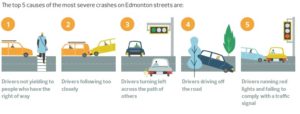
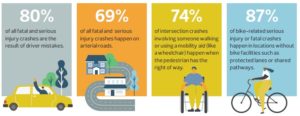
A detailed crash analysis enabled the City to develop a High Injury Network, broken down by mode, to identify specific corridors where serious injury and fatal crashes happen more frequently. Simultaneously, an Equity Analysis was conducted to help understand how different populations experience transportation safety across Edmonton.
These quantitative data sources were complemented by an engagement process designed to capture the lived experience of Edmontonians. “Achieving Vision Zero requires understanding the wide variety of perspectives and experiences people have in relation to our streets and paths,” says Lamarre. “Living out a robust public engagement process that found ways to be inclusive and make space for voices we don’t typically hear from through online and event-based engagement mechanisms was a critical priority for me. Although we couldn’t do that safely due to COVID-19, I’m satisfied with the public engagement that did take place. Knowing that we just scratched the surface, that’s fuel for us to relentlessly pursue better information, perspective and community engagement in how we live out this strategy.”
The SMS identified four Themes and associated Key Actions that outline the critical steps necessary for a successful outcome. These actions effectively embed the strategy into the corporate culture of the City by connecting directly to broader policy goals of health, climate resilience, prosperity, and building urban places for people.
“We quickly learned that safe mobility is impacted by just about anything related to our streets, paths, and spaces,” says Lamarre. “I’ve found myself listening to my colleagues from all parts of the City organization and wondering how seemingly unrelated things can help make our streets safer and more livable. If we want to reach Vision Zero, we need to think holistically and consider every lever we have available to make change.”
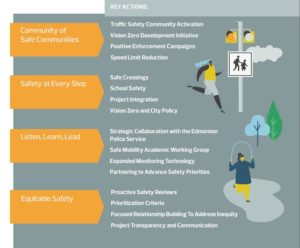 Golly concurs. “There was tremendous discussion and debate around many of the actions, and it was exclusively focused on creating an effective strategy that would enable all those different departments and branches to contribute to safe mobility in Edmonton. It was inspiring to see a genuine curiosity and interest in how our analyses could help inform decision-making, and how existing programs, policies, practices and even projects could be adjusted to achieve a common goal.”
Golly concurs. “There was tremendous discussion and debate around many of the actions, and it was exclusively focused on creating an effective strategy that would enable all those different departments and branches to contribute to safe mobility in Edmonton. It was inspiring to see a genuine curiosity and interest in how our analyses could help inform decision-making, and how existing programs, policies, practices and even projects could be adjusted to achieve a common goal.”
The final 40-page Safe Mobility Strategy is the culmination of several detailed technical studies and discussion papers, including the crash and equity analyses, and two volumes of input generated by the public engagement process.
Lamarre confidently assures Edmontonians they won’t have to wait to see the strategy implemented. “The great news is, it’s already in action. Many of our successful programs are continuing and being enhanced and expanded. Our newest program, Vision Zero Street Labs, looks to combining the lived experience and leadership of Edmontonians with support and expertise from the City to create pop-up safety projects in residential spaces using a variety of tools (both tried and true and non-traditional!). I’m particularly excited about this work, and we’ll be working with citizen teams to see projects come to life in the spring and summer.”
The City of Edmonton’s traffic safety website has a wealth of information in addition to the Safe Mobility Strategy. You can chart the progress of the 2016-2020 Road Safety Strategy through a series of annual reports, discover how the City has reduced its default speed limit, and explore the resources that contributed to the new strategy. We also highly recommend looking at the ConnectEdmonton strategic plan as well as the GBA+ tool, and the City recently published an updated bike plan that dovetails with the Safe Mobility Strategy.

